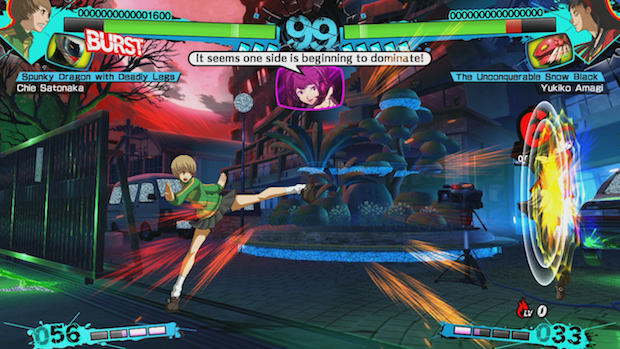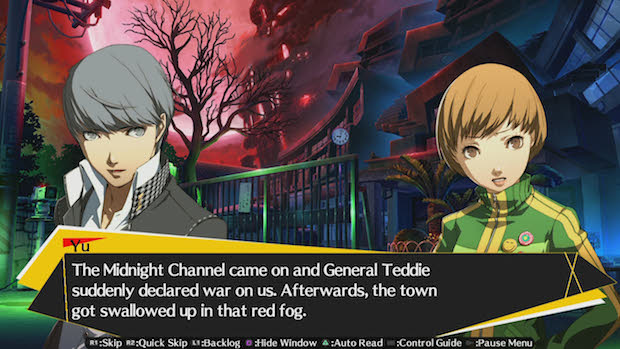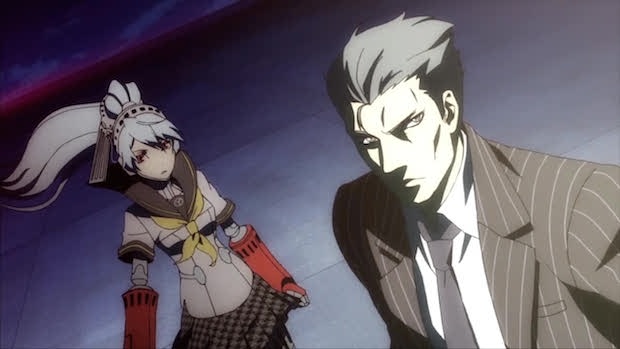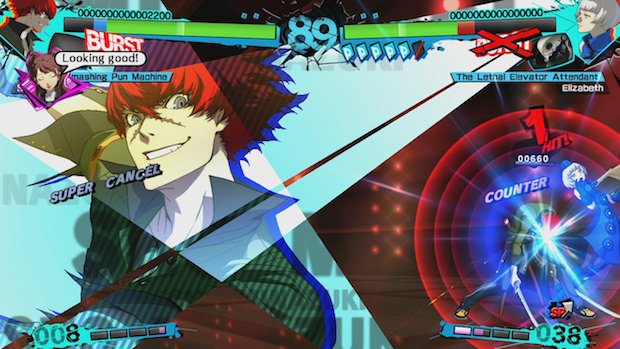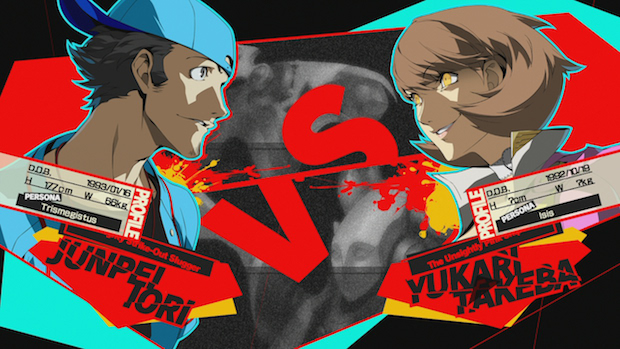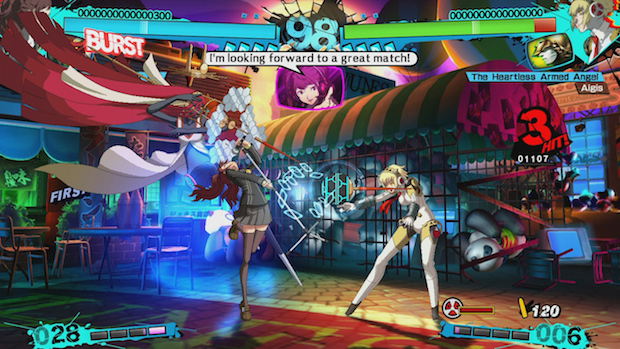
I t was a crossover that nobody ever saw coming. Persona 4 Arena could have easily been a dialed in spinoff when it was first shown off in 2012, but the smart collaboration between Atlus and Blazblue geniuses Arc System Works grew a life of it’s own in both fighting game circles and the Persona fanbase itself.
The story sacrificed nothing in it’s transition to a genre traditionally unconcerned with narrative and a surprising mechanical depth belayed the relatively easy to learn control scheme. It was almost Smash Bros-ian in it’s execution, never demanding a ton of it’s players and if they could throw a Hadouken in Street Fighter they could execute just about anything.
" Each character used their Persona in very different ways that complemented their unique gameplay style. The powerful entities were like having a completely separate character to command, but they were very vulnerable and shattered to a single attack "
About a year and a half later, Atlus and Arc System Works partner back up in time to let loose an all-out war. Bringing an end to the story began not only in the last game, but all the way back in Persona 3. To return to an earlier analogy, Ultimax is very much the Melee to Smash Bros 64, in that it takes the original concept and elevates it to a new level.
The original arena was very simple on the surface, especially compared to other, much more daunting “Anime Fighters”. Though one could pick up the title and make it through the story mode with relative ease, learning to chain moves together with your main fighter and their alter-ego made manifest, otherwise known as a Persona, is what separated the men from the boys and Arena from other fighters.
Each character used their Persona in very different ways that complemented their unique gameplay style. The powerful entities were like having a completely separate character to command, but they were very vulnerable and shattered to a single attack, taking a Persona card out of the stock. Once taken out so many times, they would become “broken” and leave players with half a move set until they recovered.
" New ways to cancel into extended combos, new ways to punish openings with fatal counters and improved short hop mechanics all bring more skill to high level play. "
Managing your Persona and character became key to the battles and mastering the game. Ultimax balances this system by granting each character their own number of the Persona Cards. Leaving Persona dependant fighters such as Yukiko with many cards, and less dependant fighters such as Akihiko with only two. On the flip side though, regeneration only takes as long as the cards you have, meaning those loaded with Persona cards have a much longer wait if their Persona gets broken.
Several other new systems were brought into the fold here, and every character has a handful of new modes to play with. The S-Hold system is a noob friendly construct that allows you to hold down the light attack button to charge up different levels of special, but it’s usefulness in actual battle is limited at best. New ways to cancel into extended combos, new ways to punish openings with fatal counters and improved short hop mechanics all bring more skill to high level play.
Potentially thanks to the addition of the S-Hold System, possibly a glitch, or possibly the game just getting obtusely more strict on their activation, I had a much harder time activating SP skills during play. Usually activated with two simple quarter circles and an attack, when trying to input them with a Dualshock 3 D-Pad they simply refused to activate. Using the left stick or an arcade stick didn’t have the same issues, leading to the confusion on why the D-pad doesn’t play nice.
" The split between the two stories feels a bit like one were to play Pokemon Black and White back to back. The differences are subtle, but both are worth playing through and offer a distinct perspective. "
Persona 4 Arena had clear problems with story structure, asking players to repeat what was mostly the same tale with each character and essentially being “Persona 4 Arena: Starring _______”. Ultimax repeats this sin, just a lot less obnoxiously by only splitting the story between an “Episode P4” and an “Episode P3”, following the exploits of the Persona 4 and 3 characters respectively.
Much like its predecessor, the two paths offer different informations and ultimate conclusions but in doing so also contradict each other. Who takes the lead, who meets up with who and battles fought all differ drastically, as well as subtle plot details. The split between the two stories feels a bit like one were to play Pokemon Black and White back to back. The differences are subtle, but both are worth playing through and offer a distinct perspective.
Ultimax had the distinct benefit of having the entirety of the original Arena as setup for its plot, and while that unfortunately gave Arena that distinct middle child feeling, Ultimax having the dominos set up for it allows it to go full throttle almost from the beginning. Picking up almost immediately after the last game ended, Ultimax jumps right back into the case.
" People who are familiar with the series will immediately recognize elements at play such as the Dark Hour and TV world intermingling and might even expect big things from the story, but to spoil as little as possible, I’ll simply say the story begins very strong but just kind of fizzles out by the end "
Ultimax throws the Investigation Team and Shadow Operatives of Persona 3 and Persona 4 right back into a new tournament after the culprit gets the leg up on them. At the stroke of midnight, the sleepy hamlet of Inaba becomes twisted into a maze as red fog descends upon the town. The General Teddie they thought was long gone after the previous events starts broadcasting on the Midnight Channel once again and ominously drops down his ultimatum: Finish the P-1 Climax within the hour or the world will end. Making matters even more urgent, he shows imagery of the main force of the Shadow Operatives up on cross-like objects.
The stakes being so high doesn’t necessarily mean there isn’t a good narrative here, and there are many peaks and valleys to the story mode. It’s tense, engaging, cheesy and ultimately very much a Persona story. Though the lack of a build up might also leave players jumping in a bit lost, it’s not hard to just enjoy the ride and though it is not under consideration for this review, a piece of early DLC will take you through the entire narrative of the original Arena, sans obtuse story structure.
People who are familiar with the series will immediately recognize elements at play such as the Dark Hour and TV world intermingling and might even expect big things from the story, but to spoil as little as possible, I’ll simply say the story begins very strong but just kind of fizzles out by the end. The final moments of the game aren’t exactly bad, but just pretty predictable aside from a cool finale with a fan favourite antagonist. There is allegedly a final ending route to tie up the story completely, but as of writing, I cannot get it to trigger at all if it’s actually on the disk.
" The amount of fan service in the title is simply incredible, and it begins with the attention to detail with the beloved characters. "
The scenario did an excellent job of setting the stage for a much wider cast than last time, bringing in a wider array of characters, primarily from Persona 3 and balancing the roster between the games far more and ballooning the fighter selection from thirteen to nineteen (again, prior to DLC).
The roster represents the best of the Persona series since Persona 3, and not only maintains all the characters, music and backdrops from the original Arena, but stacks on a ton of additional stages and music that was sorely missing from the last title. So many bases are covered that you can seriously fight to the Junes theme. The amount of fan service in the title is simply incredible, and it begins with the attention to detail with the beloved characters.
Yukari Takeba is the heaviest range fighter in the game by far, demanding command jumps and distance potshots to stay ahead of the competition, while Junpei Iori and his strange baseball driven systems show off Arc System Works character design at its best. Ken and Koromaru are probably the hardest in the game to get a handle on, fighting as one unit and having two characters and two persona between them and yet are probably the most rewarding additions to the roster for those who will learn them.
" Brand new to Ultimax are SHO Minazuki and Sho MINAZUKI (Confused yet?). "
Rise Kujikawa takes off the kid gloves herself and demands a heavy trap game with a degree of rhythm to her special moves needed for success, and she probably goes through the most persona growth in the story. Brand new to Ultimax are SHO Minazuki and Sho MINAZUKI (Confused yet?).
The Persona-less flavour of the character switches up the controls to be more reminiscent of Blazblue, with light, medium and heavy attacks, as well as some stunning command dodges to outmanoeuvre the more dexterous persona users, though as a result he lacks any real long range options himself. Meanwhile the Persona equipped Minazuki is far more brutal and dextrous, able to teleport around the battlefield to mix-up opponents and dish out punishment.
On top of the wider cast, which now covers off just about any play style one could be looking for, most of the cast also has a “Shadow Mode” counterpart. Based off the Shadow Selves seen in Persona 4 thematically and “Ura” characters from other titles functionally, these are at their core, a different and far more offence oriented spin on the fighter.
" [Shadow Fighters] reward the aggressive heavily and demand an intimate knowledge of the fighter to use to their full potential. "
They lose a chunk of meter and drop defensive techniques like a combo breaking burst and awakenings in favour of being far more durable and gaining meter more quickly. They reward the aggressive heavily and demand an intimate knowledge of the fighter to use to their full potential. They gain a “Shadow Rage” mode in place of the burst that can be triggered once their SP bar is at it’s max and allow unlimited SP use and allow moves to chain that otherwise wouldn’t work for the duration of the mode.
The game is hardly complete once you’ve finished the story mode either. Arcade mode returns as something of a Story Mode lite and basic fight gauntlet as it did in the last game, while Challenge mode tasks you with mastering combos for the character of your choosing. Score attack returns, offering a difficulty select this time and letting everybody tackle the super powered opponents in this mode to give the punishing mode a shot.
Golden Arena takes a crack at the Abyss mode found within the latest Blazblue title, challenging players to tackle increasingly difficult gauntlets of fighters while growing your own stats and gaining skills to enhance your abilities beyond what is normally possible in gameplay. No mode seems superfluous and everything is fleshed out fully, offering many, many hours for the money.
" No mode seems superfluous and everything is fleshed out fully, offering many, many hours for the money. "
Persona 4 Arena Ultimax doesn’t stop borrowing from Blazblue with Golden Arena, it freely borrows from the online of Chronophantama to its great benefit. Player matches and ranked play returns from the last game, bringing along the excellent enlistment feature from Blazblue that lets players passively search for a game while playing other modes. Lobbies feature open areas where you can partake in different gameplay moods, such as an area to get used to the game, or lobbies meant for getting to know people. There is an online mode for every occasion, and getting lost in rank chasing can be as addictive as ever.
Persona 4 Arena Ultimax represents an idea taken to an extremely polished form and ultimate celebration of the series in an unorthodox way. Arc System Works and Atlus clearly put everything into this game, and the enhancements to the fighting system, new characters and styles, and the very elaborate fan service crown Ultimax as one of the best traditional fighting games I’ve played in a long time. The handful of oddities that could be glitches and a story mode that didn’t completely get rid of the issues present in the last game are still around, but they are so drastically undermined that they glide under the radar. If you’re looking to bring on the ring, Persona 4 Arena Ultimax has you more than covered.
This game was reviewed on the PlayStation 3.
The already excellent gameplay of Persona 4 Arena was iterated upon deeply within Ultimax and the game feels like one of the most complete, yet accessible fighters i've ever played because of it. New characters are a blast to play, and don't tread on the previous fighters. Even P-1 veterans feel new with several new moves a piece. Fantastic new mechanics make the game feel frantic as ever, and considering the Shadow characters, the roster has simply exploded. Story mode is much, MUCH better structured this time, almost elimination the repetitiveness it had in the original Arena, and thanks to the previous game setting it up Ultimax has the luxury of starting off strong. The excellent fan service is respectful of the source material and enhances the package as a whole.
A few control oddities are present, though I can't tell if the game is just being obtuse with it or if it's a glitch. Story mode sort of loses steam by the end, and doesn't completely get rid of the problem the original Arena had with its telling. Certain unlocks very obtuse to find.









